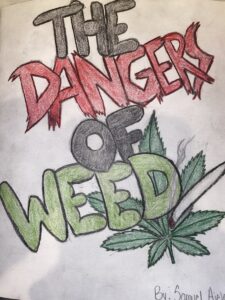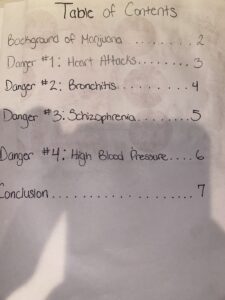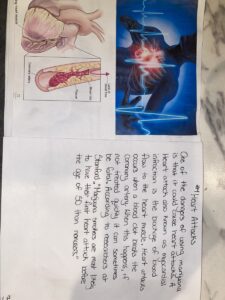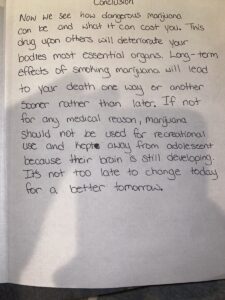Unit #1(Revised):
It was 6th grade, the start of middle school. After my 5th graduation, I felt grown up and just that guy entering the new school year. New people, New teachers, new experiences nothing is as it seems. The funny thing about the school is most of my friends from elementary school came to my middle school so it was a bit of a relief. Every morning I would get dropped off by my mom in the morning and we would listen to 100.5 phone taps and we would laugh at them together before I enter the school building. The start of school wasn’t all that bad. Not that much work to be done and I was in the school gymnasium with my friends every chance we got whether it be after lunch or during a free period we got. Fast track, Its autumn leaves are falling off trees and I can feel the cool breeze hitting my face. The way the breeze brushed past my face I can feel that winter was approaching steadily. But for the record, I like 6th grade for the most part except for the work we started to do and the smart remarks some of the teachers made. It didn’t affect me personally but it was funny to see teachers would act like that to a bunch of 11 and 12-year-olds.
It was after recess and lunch that I had my fourth class of the day. I made sure I got a sip of water before I went to class because I had just been running around for a while. It’s like I felt the water spread out to the rest of my body because of how cold that water was. It was the class I dreaded the most, English. I walked into class clenching my hoodie close to me as I said good afternoon to both my teachers. It was the middle of the first semester of 6th grade and the first essay in English will soon to be due. The bell rang so If you were late, you were late they made sure of it. “Everyone take out your first draft,” said my English teacher Ms. Gordon as she closed the door to start class locking me in for another 25 to life at least that is what it felt like. But I was lucky I wrote it the night before because who knows what would have happened if I didn’t. Did I mention I was a really bad procrastinator even still to this day? “Go grab another sheet of loose-leaf and make your 2nd draft. I was upset because I did not want to write this essay again but I had no choice anyway. So against my wishes, I wrote it again and gave it in. The next day she asked us to write it again. “Why do we keep having to write the same thing over and over again,” I said stressfully. “Until you understand what it means to read and write like a scholar,” said Ms. Gordon said firmly. So because of my little comment, she made me write it again and again and again like a sheet of never-ending paper. I was good at keeping my emotions to myself but I was angry and stressed on the inside I can’t lie. My hands were cramping up and I was losing my patience I little bit at a time but I least I was almost finished.
I had finally finished it and she read it and smile at me. “You know why I made you rewrite it all those times,” said Ms. Gordon. I said, “Why.” She said, “Because I believed that you could write me something better, and even though you didn’t want to do it u still did it and I commend you for it.” I was stunned. I thought she made me write it all those times because of the comment I made in class. She did it to teach me a lesson. Sometimes in life, you have to do things you don’t want to do but you do it because you have to. I was a little troubled after because she went to those lengths just for that when she could’ve talked to me. I felt like I didn’t need to but it was important I did because most people like me can’t see their mistakes the first time; it takes a couple of tries to make it right. She even used my work as one of the student examples to help others. But after that, she collected all of the essays to grade all of them for the first big assignment for the school year. “Now that you have your first taste of real essay,” Ms. Gordon said as she walked around the room slowly. You could hear the sound that her low-cut heel made as she walked around speaking to us. Click!Clack!Click! Clack!”Now we can begin the work you need to learn to pass the 6th grade English State Exam that would be administered by the state in March.
The English state exams were just days away but it was long overdue. I thought that rewriting that essay was bad but in reality, I had to rewrite almost every single in that class. At least I still had a hand to write with. “We made it! Today’s the day I been pushing you so hard,” said Ms. Gordon ecstatically. I was just glad that after this test I wouldn’t have to write anymore. She walks slowly over to me and says, “I’m proud of how much you’ve grown as a writer and doing what had to be done even though you didn’t want to. I smiled as I packed up my stuff in my bag getting ready for dismissal because tomorrow would be the test. While I’m taking the test, I feel at ease doing this because of the practice I got. Even one of the poems that we read in class was on the test. After the test was finished, we stayed in the gym for the day with all the students and teachers. I went over to my English teacher Ms. Gordon and said a simple, “Thank you.” She smiled and said, “You welcome,” as she hugged me. At the end of the school year, She handed me my test score and says, “I told you” then she walked away chuckling. I opened the paper, it was a 4/4 and the feeling of excitement flooded my body. I looked over at Ms.Gordon and smiled as I remembered what she had told me months ago, “Sometimes in life you have to do things you don’t want to do but you do it because you have to.” I felt that writing over and over again made my writing better also because it helped me see my mistakes more clearly and what I can do to fix them to the best of my ability.
Unit #2:
How does Marijuana affect the human body?
Introduction:
There’s been a question that has been lingering for quite some time. How does marijuana affect the human body? I was interested in learning about this because as a kid I was taught drugs were bad and I see most people especially adults and teens smoking marijuana almost every single day. I expect to find out what happens when you smoke marijuana and the effects of it whether they be short-term or long-term effects. If I find information that goes against what I expected to find, I will not throw it away. I will write about it one way or another assuming that the information goes totally against it. I will change my assumptions and be open to new possibilities because this is something I’m interested in.
Source Entry #1:
WHO. Health and Social Effects of Nonmedical Cannabis Use (the), World Health Organization, 2016. ProQuest Ebook Central, http://ebookcentral.proquest.com/lib/citytech-ebooks/detail.action?docID=5910096.
Created from citytech-ebooks on 2022-10-20 05:30:34.
The book, “The Health and Social Effects of Non-medical marijuana” created by the World Health Organization (W.H.O) based in Switzerland explains the effects of marijuana health-wise and social-wise. Marijuana or also known as cannabis is a psychoactive dried flower bud, leaves, or preparations (such as hashish) or chemicals (such as THC) that are derived from the cannabis plant. Marijuana came from Central Asia before people brought marijuana to Europe, Africa, and the Americas. This drug can be smoked like a cigarette or through a bong. Before marijuana was used for medical purposes but now it is mostly used as a recreational drug nowadays. When marijuana is smoked and inhaled, the chemical known as THC (Tetrahydrocannabinol) is released through the bloodstream. THC (Tetrahydrocannabinol) is the main component in marijuana that is responsible for psychological effects. After being smoked, THC floods the body with its chemical creating the infamous so-called “high.” The marijuana “high” results from THC’s impacts on the nerve cells that control sensory perception and pleasure. When high, you develop an increased appetite and the feeling of a relaxed state. According to the book it states, “These conditions apply to the short-term euphoric and relaxing effects sought by cannabis users and to some of its dysphoric effects (e.g. anxiety symptoms that are experienced by some users).” some other symptoms include euphoria and disinhibition, anxiety or agitation, suspiciousness or paranoid ideation, temporal showing (a sense that time is passing very slowly, and/or the person is experiencing a rapid flow of ideas, impaired judgment, impaired attention, impaired reaction time, auditory, visual, or tactile illusions; hallucinations with preserved orientation; depersonalization, derealization, and interference with personal functioning. Over time this drug can become highly addictive to have psychological disadvantages like lowering brain function and frequent mood swings.
The organization that wrote this article is the World Health Organization (W.H.O.). “World Health Organization is the United Nations agency that connects nations, partners, and people to promote health, keep the world safe and serve the vulnerable so everyone everywhere can attain the highest level of health. Founded in 1948, WHO leads global efforts to expand universal health coverage. They direct and coordinate the world’s response to health emergencies.” The primary audience is teens and adults who smoke or want to learn more about t. Another audience might be teachers using this to teach kids about drug use. They get their message across by using an informative tone to explain the effects to the readers. You can tell how this organization uses an informative technique when details and descriptions are written without bias. The agency posted this to educate and inform people about this popular drug and what it can do to your body mentally and physically. To learn more about this, you can search it on their website, www.who.int.
Key Quotes:
- “The short-term effects of cannabis use are those that can occur shortly after a single occasion of use. These short-term effects depend on the dose received, the mode of administration, the user’s prior experience with cannabis, any concurrent drug use, and the “set and setting” – i.e. the user’s expectations, attitudes towards the effects of cannabis, mood state, and the social setting in which it is used (Fehr & Kalant, 1983)”
- “This report evaluates the evidence on whether long-term cannabis use is a contributory cause of the following health outcomes: dependence, cognitive impairment, mental disorders (psychoses, depression, anxiety, and suicidal behavior), and adverse physical health effects such as cardiovascular disease (CVD), chronic obstructive pulmonary disease and respiratory and other cancers. More information can be found in chapters 6 and 7 of this report.”
- “Brain imaging studies comparing school students who are regular long-term cannabis users and non-using students typically find poorer cognitive performance and large decreases in perfusion in the former using SPECT scans (Mena et al., 2013). These changes could partially explain the lower educational attainment and lower grades among chronic cannabis users (Volkow et al., 2014a) and are discussed in more detail in section 6.1.2.”
Source #2
Frysh, Paul. “Effects of Marijuana Use: How Weed Affects Your Mind & Body.” WebMD, WebMD, 19 Dec. 2021, https://www.webmd.com/mental-health/addiction/marijuana-use-and-its-effects.
The article, “How Pot Affects Your Mind and Body ” discusses the effects marijuana has on the body. It shows all the side effects that people could have from being paranoid to being hungry more often. The article tells us, “Marijuana can make it harder for you to focus, learn, and remember things. This seems to be a short-term effect lasting 24 hours or longer after you stop smoking. But using pot heavily, especially in your teen years, may leave more permanent effects. Imaging tests with some — but not all — adolescents found that marijuana may physically change their brains. Specifically, they had fewer connections in parts of the brain linked to alertness, learning, and memory, and tests show lower IQ scores in some people.” This means that this drug makes focusing and learning things harder and that is more common with adolescents and teenagers which reflects on test scores, school work, etc. Different studies show that marijuana causes increased appetite for some people. This side effect can be helpful for people who suffer illnesses that cause people not to gain weight. According to the article it also states, “Marijuana can cloud your senses and judgment. The effects can differ depending on things like how potent your pot was, how you took it, and how much marijuana you’ve used in the past. It might: Heighten your senses (colors might seem brighter and sounds might seem louder), Distort your sense of time, Hurt your motor skills and make driving more dangerous, Lower your inhibitions so you may have risky sex or take other chances” This is one of the most common sides from marijuana. It feels like you can see everything more clearly and time has slowed down but not at all. It is just the chemical in the marijuana, THC, tampering with your brain functions, making you have that euphoric feeling.
“How Pot Affects Your Mind and Body ” was created and published by Paul Frysh. Paul Frysh is a senior health writer who writes for WebMD. Frysh is from South Africa originally and has been writing for almost 20 years. Frysh has written many pieces for newspapers, videos, magazines, etc on topics containing Science, education, medicine, etc. He has been writing for WebMD since 2016 about health and medical-related issues. He has also won two Peabody awards for his team at CNN Digital and his coverage of the news about the 2008 presidential election and Hurricane Katrina. This article was published and then reviewed by Dr. Jennifer Casarella on December 19, 2021. The primary audience is adolescents, teens, and adult who smoke marijuana or is thinking about it. The secondary audience is people who don’t smoke to see what marijuana does to a person without actually doing it. The purpose of this article was to inform the readers of the different side effects marijuana has on someone. The genre of this article is nonfiction because it expresses facts about this drug that can be verified in real life. This is the best genre to address the audience because it is facts that can be backed up by other sources without bias and/or opinions. The author’s tone is very informative in the way it was written. Frysh wrote this without putting any of his feeling and opinions in the article. This answers my question because it clearly shows and states what marijuana does to the body without biased opinions. This can be verified through other sites like the CDC(Centers for Disease Control and Prevention) and books. Frysh also had his own cited sources listed at the end of his article.
Key Quotes:
- “Marijuana can make it harder for you to focus, learn, and remember things. This seems to be a short-term effect that lasts for 24 hours or longer after you stop smoking. But using pot heavily, especially in your teen years, may leave more permanent effects. Imaging tests with some — but not all — adolescents found that marijuana may physically change their brains. Specifically, they had fewer connections in parts of the brain linked to alertness, learning, and memory, and tests show lower IQ scores in some people.”
- “Marijuana can cloud your senses and judgment. The effects can differ depending on things like how potent your pot was, how you took it, and how much marijuana you’ve used in the past. It might:
- Heighten your senses (colors might seem brighter and sounds might seem louder)
- Distort your sense of time
- Hurt your motor skills and make driving more dangerous
- Lower your inhibitions so you may have risky sex or take other chances”
- “Not everyone’s experience with marijuana is pleasant. It often can leave you anxious, afraid, panicked, or paranoid. Using marijuana may raise your chances for clinical depression or worsen the symptoms of any mental disorders you already have. Scientists aren’t yet sure exactly why. In high doses, it can make you paranoid or lose touch with reality so you hear or see things that aren’t there.”
Source #3
CDC. “Health Effects of Marijuana.” Centers for Disease Control and Prevention, Centers for Disease Control and Prevention, 2 June 2021, https://www.cdc.gov/marijuana/health-effects/index.html.
The article, “Health Effects of Marijuana” discusses the different ways in which marijuana affects different parts of the body. The article states, “Marijuana can make the heart beat faster and can make blood pressure higher immediately after use. It could also lead to an increased risk of stroke, heart disease, and other vascular diseases. Most of the scientific studies linking marijuana to heart attacks and strokes are based on reports from people who smoked marijuana (as opposed to other methods of using it). Smoked marijuana delivers tetrahydrocannabinol (THC) and other cannabinoids to the body. Marijuana smoke also delivers many of the same substances researchers have found in tobacco smoke—these substances are harmful to the lungs and cardiovascular system.” This means that smoking marijuana is bad not only for your respiratory system but also for your cardiovascular system. Smoking marijuana can increase your chances of having a stroke, heart attack, etc because of the increase in blood pressure after the use of such a drug. According to the CDC, it states, “Smoked marijuana, regardless of how it is smoked, can harm lung tissues and cause scarring and damage to small blood vessels. Smoke from marijuana has many of the same toxins, irritants, and carcinogens (cancer-causing chemicals) as tobacco smoke.5 Smoking marijuana can also lead to a greater risk of bronchitis, cough, and mucus production, though these symptoms generally improve when marijuana smokers quit.” Smoking causes irritation in the chest which causes trouble breathing, etc when started. These lung issues can later lead to bronchitis, mucus production, or emphysema ( stemming from shortness of breath). All of these potential symptoms will only result in death if not careful. Whether you smoke a joint, a bong, a bowl, or a blunt all of the side effects will remain the same.
Rhetorical Analysis: “Health Effects of Marijuana” was created by the CDC. The CDC (Centers for Disease Control and Prevention) is a national public agency in the United States. The CDC is one of the best science-based organizations in the world. The CDC helps give knowledge of health-related diseases, illnesses, or outbreaks like COVID-19. The CDC wants to protect people from diseases and potential new ones like they have been doing for the past 70 years. The primary audience is adolescents, teens, and adults who smoke or want to learn more about it. Other audiences might include more people who are interested and want to learn the effects of the drug because of their curiosity about the subject. The purpose of this article was to inform the readers of the different side effects marijuana has on someone and the things it can do it the human body. The genre of this article is nonfiction because it gives us nothing about facts about this drug that can be verified in real life. This is the best genre to address the audience because it is facts that can be backed up by other sources without bias and/or opinions. The author’s tone is very informative in the way it was written because no words that resemble opinions or personal feelings were used. This answers my question because it clearly shows and states what marijuana does to the body without any biased opinions. This can be verified through other sites like the one the CDC has cited. CDC used references which are located at the bottom of the article.
Key Quotes:
- “Marijuana can make the heart beat faster and can make blood pressure higher immediately after use.1,2 It could also lead to an increased risk of stroke, heart disease, and other vascular diseases.3-7 Most of the scientific studies linking marijuana to heart attacks and strokes are based on reports from people who smoked marijuana (as opposed to other methods of using it). Smoked marijuana delivers tetrahydrocannabinol (THC) and other cannabinoids to the body. Marijuana smoke also delivers many of the same substances researchers have found in tobacco smoke—these substances are harmful to the lungs and cardiovascular system.”
- “Smoked marijuana, regardless of how it is smoked, can harm lung tissues and cause scarring and damage to small blood vessels. Smoke from marijuana has many of the same toxins, irritants, and carcinogens (cancer-causing chemicals) as tobacco smoke. Smoking marijuana can also lead to a greater risk of bronchitis, cough, and mucus production, though these symptoms generally improve when marijuana smokers quit.”
- “Edibles, or food and drink products infused with marijuana, have some different risks than smoked marijuana, including a greater risk of poisoning. Unlike smoked marijuana, edibles can:
- Take from 30 minutes to 2 hours to take effect, so some people may eat too much, which can lead to poisoning and/or serious injury.
- Cause intoxicating effects that last longer than expected, depending on the amount ingested, the last food eaten, and medications or alcohol used at the same time.
- Be unpredictable. The amount of tetrahydrocannabinol (THC), or the concentration or strength, is very difficult to measure and is often unknown in edible products. Many people who use edibles can be caught off-guard by their strength and long-lasting effects.”
Conclusion:
Overall, Marijuana affects you in various ways. Although, Marijuana is a recreational drug it has many side effects whether it be positive or negative. Marijuana is a psychoactive dried flower bud, leaves, or preparations (such as hashish) or chemicals (such as THC) that are derived from the cannabis plant that can be smoked like a cigarette or through a bong. This drug can cause a temporary high that makes you have more of an appetite, distortion of time, and that overall calm euphoric feel. In “The Health and Social Effects of Non-medical marijuana” the World Health Organization (W.H.O) explains to us the short-term effects of what happens when marijuana and its main chemical compound, Tetrahydrocannabinol (THC) enters the body. The short-term effects, come with some other minor effects as well. In “How Pot Affects Your Mind and Body ” Paul Frysh also tells us about how marijuana can cloud your senses and judgment and makes it harder for you to focus. Many people say this doesn’t happen to them but the majority can because of tests and what is shown. Lastly, the article, “Health Effects of Marijuana” by the Centers for Disease Control and Prevention (CDC) warns us about the more serious consequences of smoking including having an increased risk of a stroke, heart disease, and other vascular diseases. Also increased greater risk of bronchitis, cough, and mucus production. I was generally surprised that marijuana can cause this much damage to the human body even though it is a recreational drug and even medical depending on the situation. I always thought that marijuana had no long-term effects because of how much our society this day and age uses it. Now I understand why it is considered illegal in different states but now I wonder why cigarettes aren’t illegal too when they cause even more harm to the human body than marijuana. I learned that marijuana can benefit some people while having a negative impact on others. I believe that people of all ages who smoke marijuana need to hear about the potential dangers of this drug first before it is too late. Marijuana smokers should know what they are getting themselves into before deciding what to do with the information because at the end of the day it’s still the person’s choice whether to stop or not. It is their life and their decision but knowing what you are putting yourself into is better than not knowing at all.
Unit #3(Revised):
Final Reflection:
Over the course of this English semester, I’ve learned many skills that can help me inside and outside of school. I learned about other ways to get a point across without having to write an essay and time management for the most part. This was the first time in my college experience that I could explain my topic without writing an essay. I also noticed that throughout this semester, I can better read and understand the text more efficiently while growing as a writer.
Looking back on how I view my writing is not the way I see my writing now. Before I used to think that my writing didn’t make sense and it wasn’t enough to explain the question at hand. I felt like I didn’t believe in my writing because I had never liked to write since I was a kid. I always used to write my essay without any brainstorming what to write to better sort my ideas about what I should write. This was a very bad habit that I had and made me write longer than I should have because I didn’t know what to write. Now I learned to hit the brakes and slow down the way I write my essays without skipping the brainstorming process. This process helped me clear and sort my ideas in a time-efficient manner so writing the actual essay is quick and easy. Brainstorming is a process that should be skipped because it helps with the organization of my ideas and it will only negatively affect my writing if I continued to skip it.
During this semester, I have seen how much my work has changed since the beginning of the semester. Before the semester I wasn’t confident in my ideas and answers in my writing so it made it hard to find the answers to some questions in my writing. Now I’m more confident in my writing because of my rereading more than once and opinions on my writing from people other than myself. People viewing my work makes me look at my work from a different point of view because I always look at my writing as an author and not a reader. If I continue to look at my writing from different points of view, my writing will be greater than it already is.
During the revision cycle, I was able to see my mistakes and corrected them the way I saw fit. Also, it helped correct the tone of my essay. What was challenging for me in this class was the general fact that I never liked to write. The reason I don’t like to write is that it was always boring to me and I always had to write about something I never found interesting. I overcame this by a quote my middle school ELA teacher used to say to me that I wrote in my Unit 1 final assignment which stated, “I looked over at Ms.Gordon and smiled as I remembered what she had told me months ago, “Sometimes in life you have to do things you don’t want to do but you do it because you have to.”
Surprisingly, in this course, I didn’t have any assignments that I didn’t like because all the assignments in this course were genuinely interesting to me and I got to choose what I wanted to write for my Unit 2 assignment. But my favorite assignment in this class was the Unit #3 final assignment. In this assignment, we had to choose another way to explain the answer to my Unit 2 essay as anything other than an essay. For my unit #3, I chose to make a picture book about the dangers of marijuana. I was able to use other skills other than writing like visual art. I put pictures to show a visual representation of the dangers of marijuana with the main facts on the other page. In the book I made I put that, ” High blood pressure also known as hypertension is when the force of blood flowing against the artery walls too high. Being one of the most dangerous, high blood pressure can lead to heart failure, dementia, aneurysm, heart attacks, etc.” Without writing too much, I was able to inform the audience of the definition of the danger and what the danger can cause with a picture show where on the body it will affect. Being able to do this shows me that writing is not as bad as I thought it was. Being able to write in different forms shows the growth that I’ve developed when taking part in this course in college.











Leave a Reply